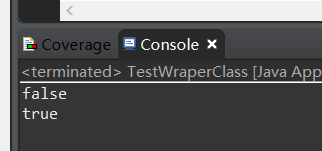都0202 了 java 1.8 已经是主流
自动装箱 、拆箱已经很普遍使用了,那么有时候是不是会遇到坑呢?
我们先来看一段代码:
public class TestWraperClass {
public static void main(String[] args) {
Integer a = 200;
Integer b = 200;
Integer c = 123;
Integer d = 123;
System.out.println(a == b);
System.out.println(c == d);
}
}
运行结果:

代码中 a==b 结果为false 容易理解,毕竟是两个不同对象;
那么 c == d 为什么结果会是 true 呢?
其实在程序编译时,编辑器会给我们的代码加上 Integer.valueOf(int i)。
即上面的代码相当于:
Integer a = Integer.valueOf(200);
Integer b = Integer.valueOf(200);
Integer c = Integer.valueOf(123);
Integer d = Integer.valueOf(123);
我们可以按住CTRL键鼠标点击valueOf 查看JDK源码有这么一段代码:
public static Integer valueOf(int i) {
if (i >= IntegerCache.low && i <= IntegerCache.high)
return IntegerCache.cache[i + (-IntegerCache.low)];
return new Integer(i);
}
也就是说,当给 Integer.valueOf(int i) 出入的参数在某个范围内是,会直接从一个数组中取值
我可以继续按住CTRL键鼠标点击 cache 进入 IntegerCache 类,我们可以看到源码如下:
private static class IntegerCache {
static final int low = -128;
static final int high;
static final Integer cache[];
static {
// high value may be configured by property
int h = 127;
String integerCacheHighPropValue =
sun.misc.VM.getSavedProperty("java.lang.Integer.IntegerCache.high");
if (integerCacheHighPropValue != null) {
try {
int i = parseInt(integerCacheHighPropValue);
i = Math.max(i, 127);
// Maximum array size is Integer.MAX_VALUE
h = Math.min(i, Integer.MAX_VALUE - (-low) -1);
} catch( NumberFormatException nfe) {
// If the property cannot be parsed into an int, ignore it.
}
}
high = h;
cache = new Integer[(high - low) + 1];
int j = low;
for(int k = 0; k < cache.length; k++)
cache[k] = new Integer(j++);
// range [-128, 127] must be interned (JLS7 5.1.7)
assert IntegerCache.high >= 127;
}
private IntegerCache() {}
}
看关键代码:

很明显可以看到 IntegerCache.cache[i + (-IntegerCache.low)] 其实就是一个 从-128 到 127 的 静态初始化 Integer 数组 ,当我们调用时,已经存在java 虚拟机的堆中了,不需要重新创建。
那么回到最开始的代码:
当我们创Integer 对象的值在[-127, 128] 范围时,其实取的都是 cache[] 数组的同一个对象。
至此,已经可以很好结算 开始代码的运行结果了。